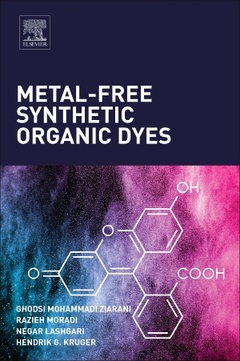Description
Metal-Free Synthetic Organic Dyes
Authors: Mohammadi Ziarani Ghodsi, Moradi Razieh, Lashgari Negar, Kruger Hendrik G.
Language: English
Subject for Metal-Free Synthetic Organic Dyes:
Keywords
?�?? ???? ?-Conjugated structures; ?-Conjugated system; Amine dyes; Aminosquarylium dyes; Anthraquinone; Antimicrobial activities; Azo dyes; Azo-dye polymers; Bathochromic shift; Bioimaging; BODIPY dyes; Carbazole dyes; Charge transfer; Color change; Conjugated system; Cotton; Coumarin dyes; Cross-linking; Cyanine dyes; Diazo dye; Donor materials; Donor�?�acceptor type dyes; Dye sensitizer; Dyeing; Dye-sensitized solar cell; Dye-sensitized solar cells; Dye-synthesized solar cells; Electron donor; electron transition; electronic transition; Electronic transitions; Fiber; Fluorene; Fluorescein; Fluorescence; Fluorescent dye; Fluorescent probe; Fluorescent; Hemocyanine dyes; Hypsochromic shift; Imides; Industry; Intermolecular charge transfer; Intramolecular charge transfer; Labeling cells; Miscellaneous dyes; Monoazo dye; Naphthalimide; Near-infrared; Nylon 6Protein assay; Organic dyes; Oxazine dyes; Phenothiazine dyes; Phenylamine organic dyes; Photoactive dye; Photochromic; Photosensitizer; Probe; Quantum yield; Redshift; Rhodamine; Sensitizer; Sensitizers; Solar cells; Solvatochromic effect; Solvatochromism; Solvent effect; Solvent polarity; Spirooxazine; Squanaine dyes; Squaric acid; Stokes shift; Stokes shifts; Synthetic dyes; Thiophene dyes; transition absorption; transition; transitions; Triazine dyes; Wastewater application; Xanthene ring
171.65 €
In Print (Delivery period: 14 days).
Add to cart286 p. · 15x22.8 cm · Paperback
Description
/li>Contents
/li>Readership
/li>Biography
/li>Comment
/li>
Metal- Free Synthetic Organic Dyes is a comprehensive guide to the synthetic, organic dyes that are classified by their chemical structure. As synthetic dyes are playing an increasingly important role in modern life, with applications in both industry and scientific research, this book provides insights on the many research attempts that have been made to explore new photosensitizers in the development of dye sensitized solar cells (DSCs). These novel photosensitizers have incorporated, within their structure, different organic groups, such as coumarins, cyanines, hemicyanines, indolines, triphenylamines, bis(dimethylfluorenyl) aminophenyls, phenothiazines, tetrahydroquinolines, carbazoles, polyenes, fluorenes, and many others.
This comprehensive resource contains color figures and schemes for each dye discussed, and is an invaluable resource for organic, inorganic and analytical chemists working in academia and industry.
The target audience should be M.Sc students and Ph.D. students of organic chemistry, inorganic chemistry and analytical chemistry. Dye industry, pigments industry, textile industries, colour science, solar energy materials and solar cells, biomedical sensors, advanced materials, structure and synthesis of materials, advances in colour and polymer sciences, and applications of dyes and pigments.
Razieh Moradi obtained her B.Sc. degree in Chemistry from the University of Lorestan (2012) and her M.Sc. degree in Organic Chemistry at Alzahra University under the supervision of Dr Ghodsi Mohammadi Ziarani. She is currently Ph.D. student in Organic Chemistry at Alzahra University under the supervision of Dr Ghodsi Mohammadi Ziarani. Her research field is on the synthesis of heterocyclic compounds, synthesis of organic dyes and application of nano-heterogeneous catalysts in organic synthesis and multicomponent reactions.
Negar Lashgari received her B.Sc. degree in Applied Chemistry from Teacher Training University, Tehran, Iran (2008) and her M.Sc. degree in Organic Chemistry at Alzahra University, Tehran, Iran (2011) under the supervision of Dr Ghodsi Mohammadi Ziarani. She obtained her Ph.D. degree in Nano Chemistry from University of Tehran under the supervision of Dr Alireza Badiei and Dr Ghodsi Mohammadi Ziarani in 2017. Her research field is synthesis and functionalization of mesoporous silica materials and their application as nano-heterogeneous catalysts in multicomponent reactions and also as chemosensors for detection of various anions and cations.
Dr. Kruger graduated from Potchefstroom Unive
- Features a discussion of the synthesis of the new, high-value synthetic dyes and pigments and their applications and performance
- Includes coverage of new photosensitizers and their role in the development of dye sensitized solar cells (DSCs)
- Covers synthesis of the functional dyes that are ideal for applications in the dye and pigment industry, textiles, color science, solar energy materials and solar cells, biomedical sensors, advanced materials, structure and synthesis of materials, and more




